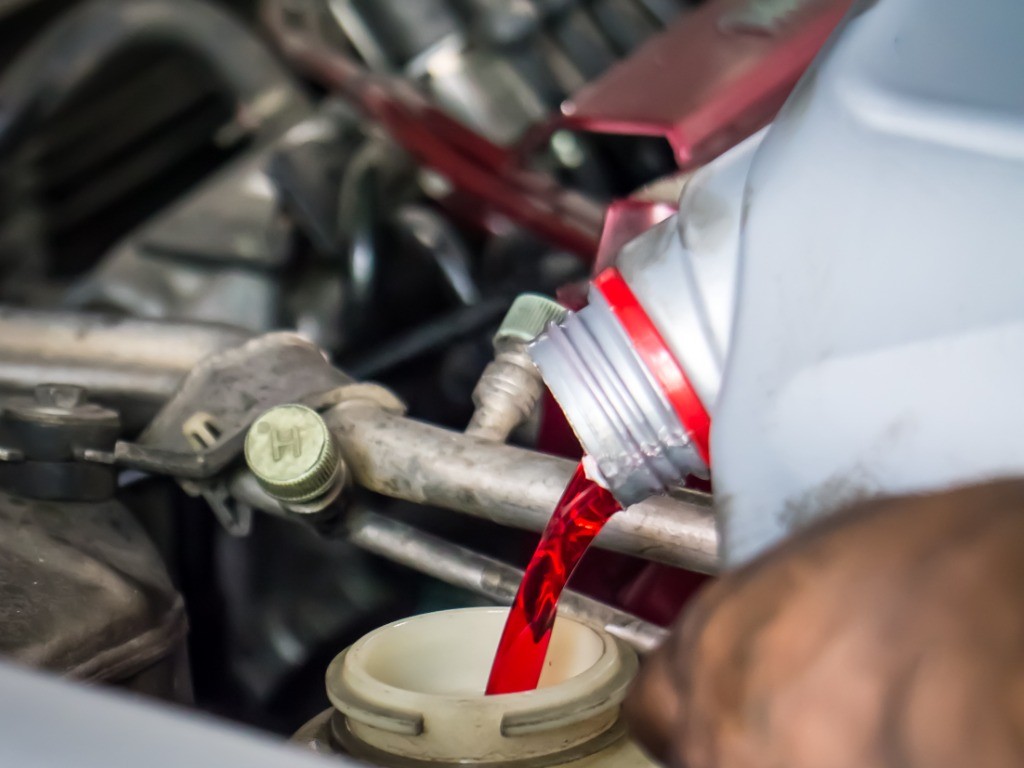It’s a frustrating moment for any driver: you shift your car into reverse, but nothing happens. Your engine might rev, but your vehicle refuses to back up. This problem, where your car won’t reverse but still moves forward, can be more than just an inconvenience – it can disrupt your day and raise concerns about your car’s health. Understanding the reasons behind this issue is the first step to getting back on the road safely. Let’s dive into the common culprits behind why your car might be refusing to go in reverse.
 Hand adding transmission fluid to a car, illustrating a potential solution for low transmission fluid causing reverse failure
Hand adding transmission fluid to a car, illustrating a potential solution for low transmission fluid causing reverse failure
Common Reasons Why Your Car Isn’t Reversing
Several factors can lead to your car’s inability to reverse. From simple fluid issues to more complex mechanical failures, pinpointing the cause is crucial for effective repair. Here are some of the most frequent reasons why your car might be stuck in forward gear only.
Low Transmission Fluid
Just like engine oil is vital for your engine’s smooth operation, transmission fluid is essential for your transmission. This fluid lubricates the internal components, allowing them to move freely and without damage. In automatic transmissions, it also acts as a coolant, preventing overheating. If your transmission fluid level is low, it can lead to various problems, including issues shifting into reverse. Without enough fluid, there might not be sufficient hydraulic pressure to engage the reverse gear.
However, it’s important to note that low transmission fluid usually affects all gears, not just reverse. If your car shifts into drive and other forward gears without issue, low fluid might not be the primary cause, but it’s still a good starting point to check.
Fix: Checking and topping off your transmission fluid is a relatively simple DIY task. Consult your car’s owner manual for the correct type of transmission fluid and the procedure for checking and filling it. However, remember that transmission systems are closed systems. If you find your fluid level is low, it indicates a potential leak that needs further investigation.
Contaminated Transmission Fluid
Over time and use, transmission fluid can become contaminated with small particles and debris from within the transmission system. This degradation of fluid quality can compromise its lubricating properties and lead to damage. Severely contaminated fluid might not properly lubricate the transmission components, potentially hindering the engagement of reverse gear. Similar to low fluid levels, contaminated fluid often affects all gears, but it’s still a possible cause for reverse gear problems.
Fix: Changing your transmission fluid is akin to changing your engine oil and is a routine maintenance task. Locate the transmission fluid drain plug, usually underneath your car. Drain the old fluid into a pan, replace the drain plug, and refill with fresh, manufacturer-recommended transmission fluid. If you prefer professional service, a transmission fluid change typically costs between $100 and $200 at a mechanic.
Broken Reverse Gear
While less common, a broken reverse gear is a possibility in both automatic and manual transmissions. This can occur due to normal wear and tear over time or, in manual transmissions, from repeated grinding or stripping of the gear teeth. If the reverse gear is damaged, it may prevent your car from engaging reverse, while forward gears remain functional.
Fix: Replacing a broken reverse gear is a more complex repair, typically requiring transmission removal and disassembly. Mechanic costs for this repair can start upwards of $1,000. DIY repair is possible for experienced individuals, involving draining the transmission fluid, removing the transmission, disassembling it to replace the gear, and reassembling everything. Given the complexity, it’s often advisable to replace other worn parts during this process.
Malfunctioning Lockout Ring (Manual Transmissions Only)
This issue is exclusive to manual transmissions. The lockout ring is a safety mechanism designed to prevent accidental shifting into reverse while the car is moving forward, which could cause serious damage. If the lockout ring malfunctions, it might mistakenly prevent you from shifting into reverse even when the car is stationary.
Fix: Replacing a faulty lockout ring is generally a more affordable repair, typically ranging from $100 to $300. DIY replacement can be done by putting the car in reverse, removing the shifter head, replacing the old lockout ring with a new one, and reassembling the shifter.
Faulty Shift Mechanisms
Both automatic and manual transmissions rely on shift mechanisms to select gears. In automatic transmissions, this often involves shift cables, while manual transmissions use linkages. Damaged or stretched shift cables or misadjusted shift linkages can prevent the vehicle from properly engaging reverse gear. These issues can arise from wear and tear, damage, or improper adjustment.
Fix: Adjusting shift linkages can sometimes resolve the issue. For example, tightening the nuts behind the transmission cable bracket while the car is in neutral and having someone shift into reverse can help. Repeat this process until the cables are correctly tightened, but avoid overtightening. Professional repair for shift mechanism issues usually costs between $300 and $500.
Malfunctioning Position Sensor (Automatic Transmissions Only)
Automatic transmissions rely on the car’s Engine Control Unit (ECU), the onboard computer, to manage gear shifting. When you move the gear shifter into reverse, a position sensor sends a signal to the ECU to engage reverse gear. If this sensor fails, the ECU might not receive the signal, preventing the car from shifting into reverse. In some cases, a faulty sensor might also prevent the shifter itself from moving into the reverse position.
Fix: Electrical repairs, such as position sensor replacement, are generally best left to professionals unless you have significant experience with automotive electrical systems. Mechanic costs for replacing a transmission position sensor typically range from $300 to $500.
Troubleshooting and Fixes
To summarize, here’s a quick troubleshooting guide:
- Check Transmission Fluid Level and Condition: This is the easiest first step. Low or dirty fluid is a common issue.
- Listen for Noises: Any unusual grinding or clunking sounds when attempting to reverse? This could indicate a broken gear or mechanical issue.
- Test Other Gears: Does the problem only occur in reverse, or are other gears also affected? Widespread gear issues often point to fluid problems or more significant transmission damage.
- Consider Recent Repairs: Have you had any recent work done on your car, particularly involving the transmission or shifter? A recent repair might be related to the issue.
When to See a Mechanic
While some of the fixes mentioned above are DIY-friendly, especially checking and changing fluids, other issues are more complex and require professional expertise. It’s recommended to consult a qualified mechanic if:
- You are uncomfortable working on your car’s transmission.
- You suspect a broken reverse gear or internal transmission damage.
- You are dealing with electrical issues like a faulty position sensor.
- Simple fixes like fluid top-off or change don’t resolve the problem.
- You are unsure about the cause of the problem.
A professional diagnosis will accurately pinpoint the cause of your car’s reverse issue and ensure the correct repair is performed.
FAQ/People Also Ask
Car won’t reverse but will go forward: This could range from a simple shift cable adjustment to internal transmission component damage requiring replacement.
How to fix a car that won’t go in reverse: Unfortunately, there’s no single fix. It could be as minor as adding transmission fluid or as major as a complete transmission rebuild.
Car won’t go into reverse manual: Typically, manual transmissions with reverse issues often have a damaged gear or a problem with the shift lockout ring mechanism.
Why won’t my car move when I put it in drive or reverse? If no drive gear engages, it could be due to fluid leaks, broken internal parts, or shift cable problems. A complete diagnosis is needed.
How much to fix a car that doesn’t reverse? Repair costs can vary widely, from under $20 for fluid to over $2,500 for a new transmission, excluding labor. Accurate cost estimation requires a professional diagnosis.
